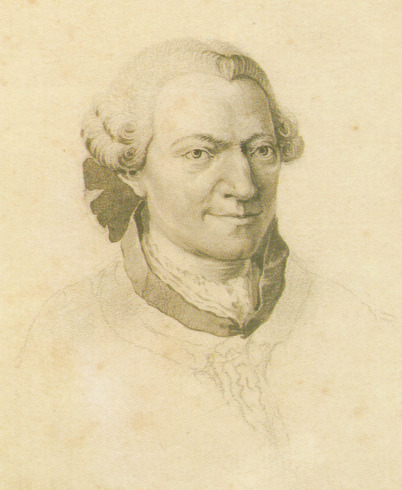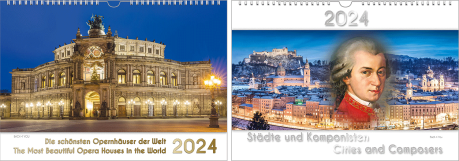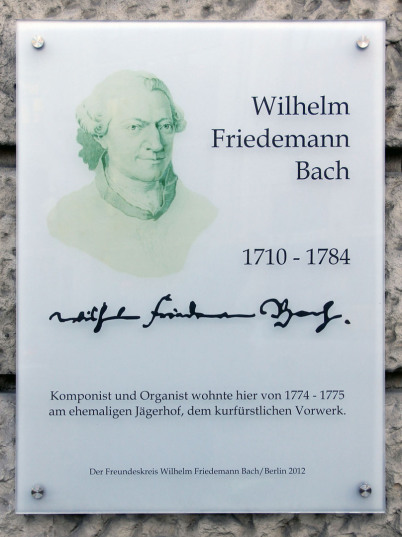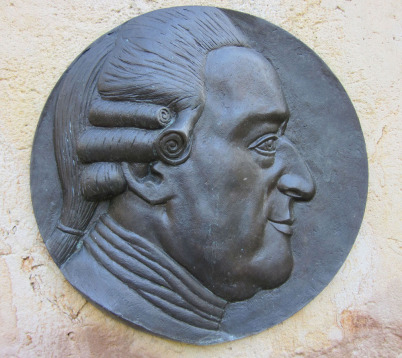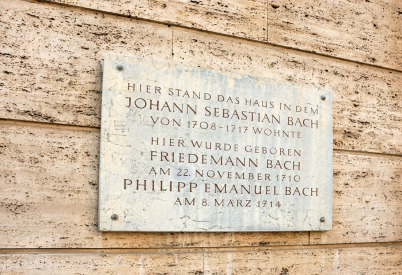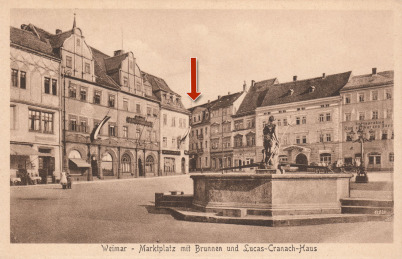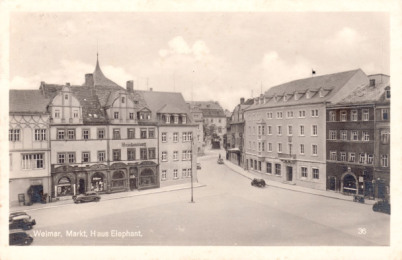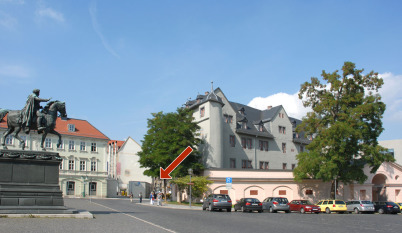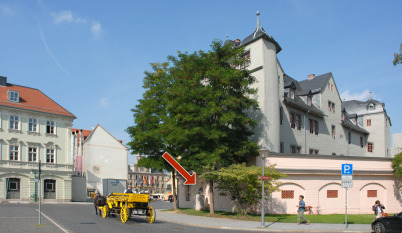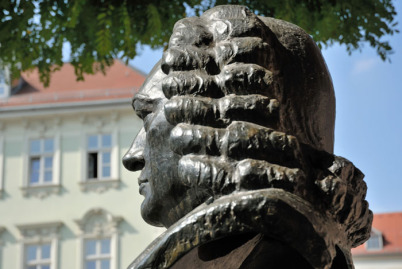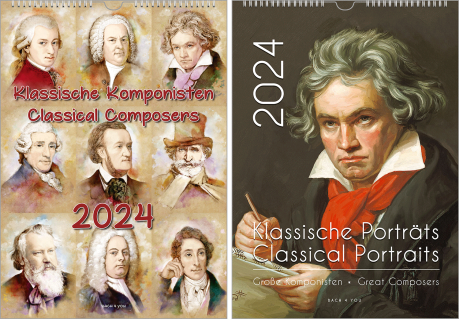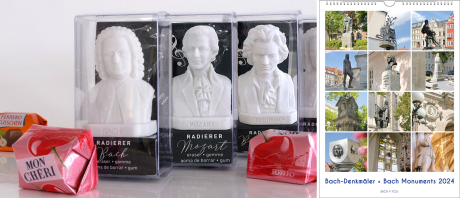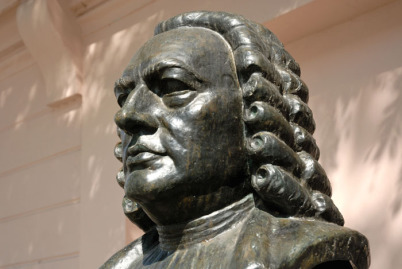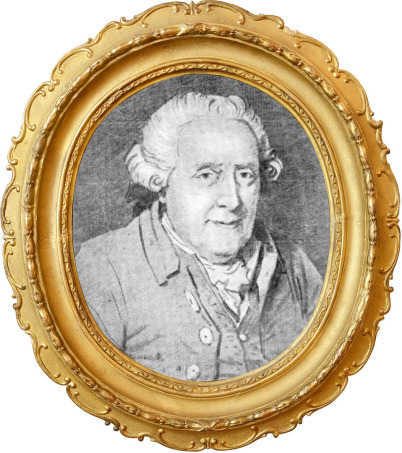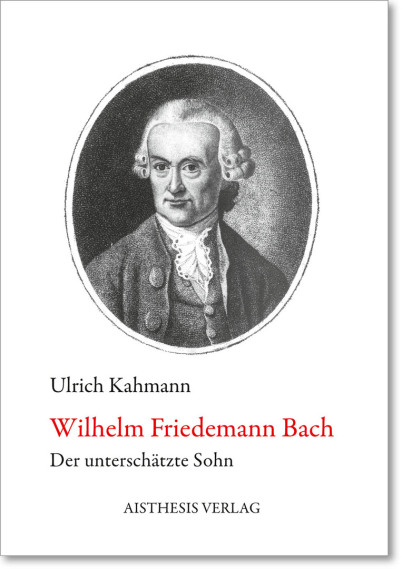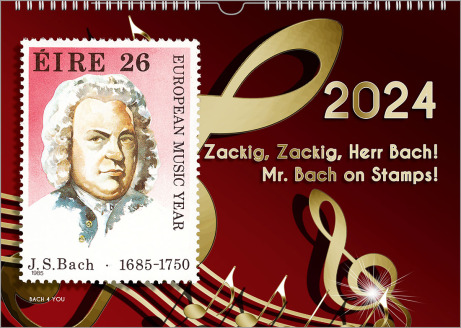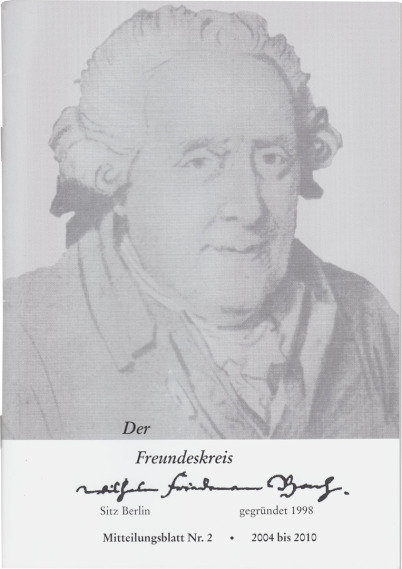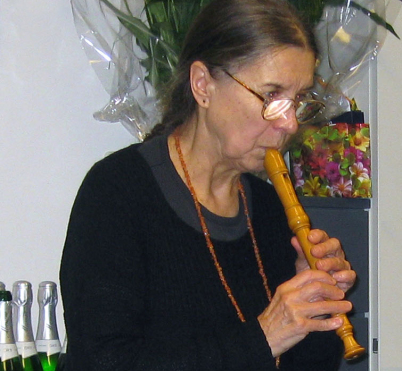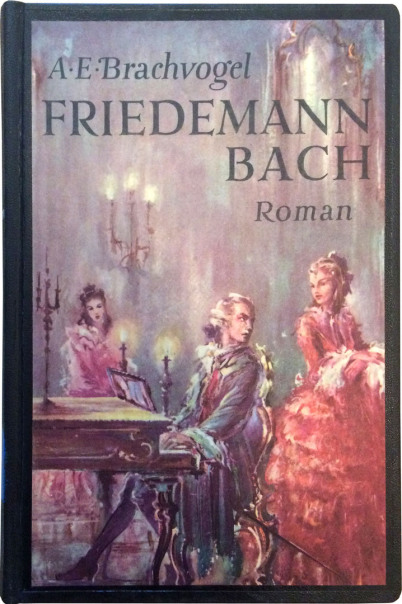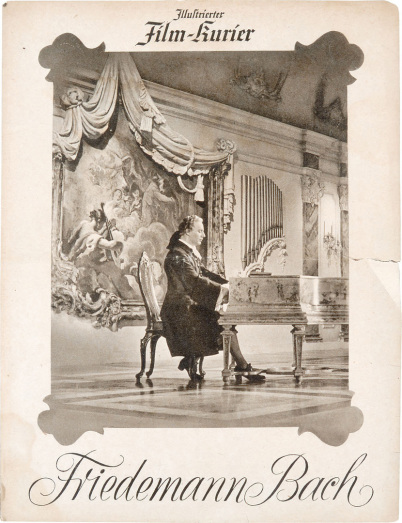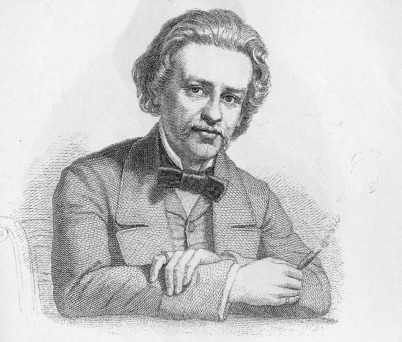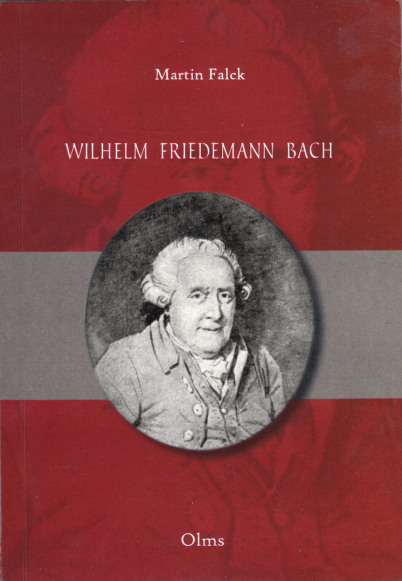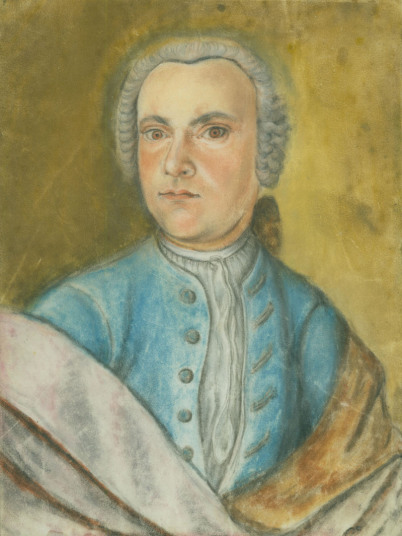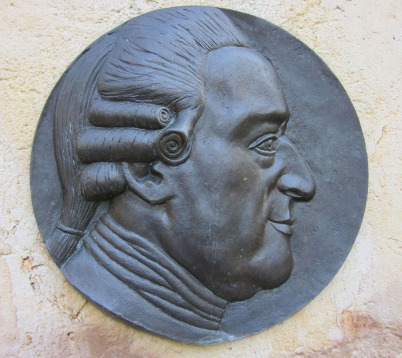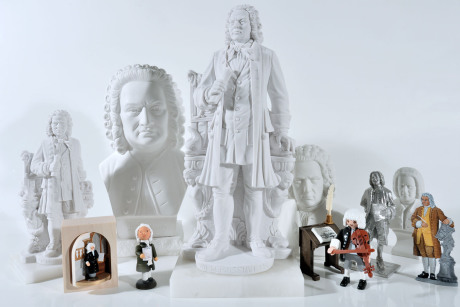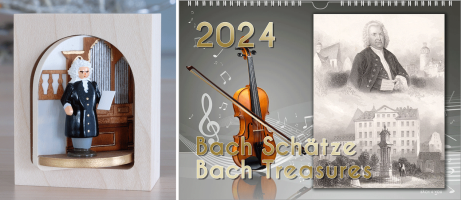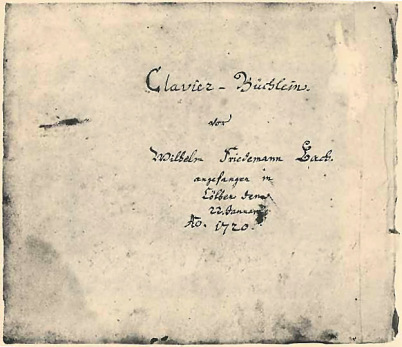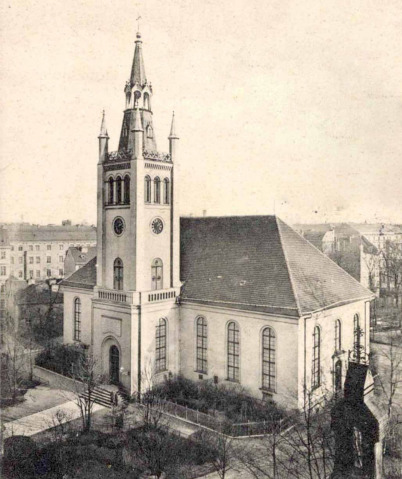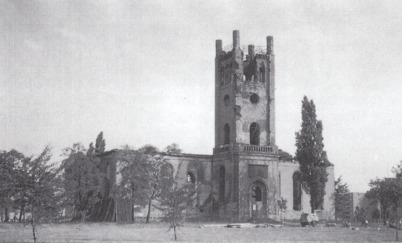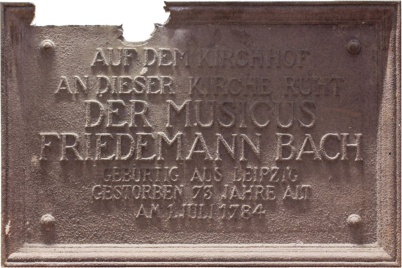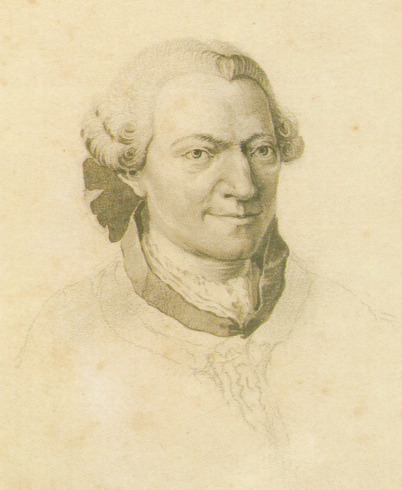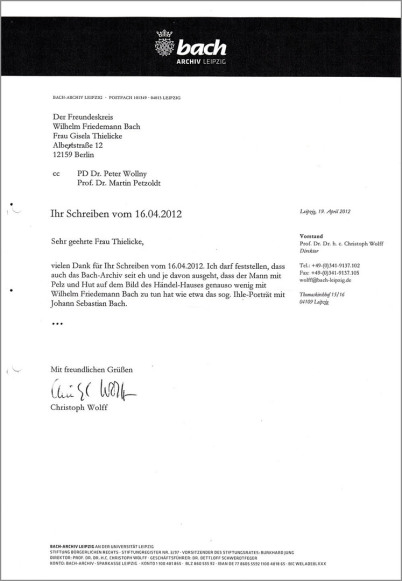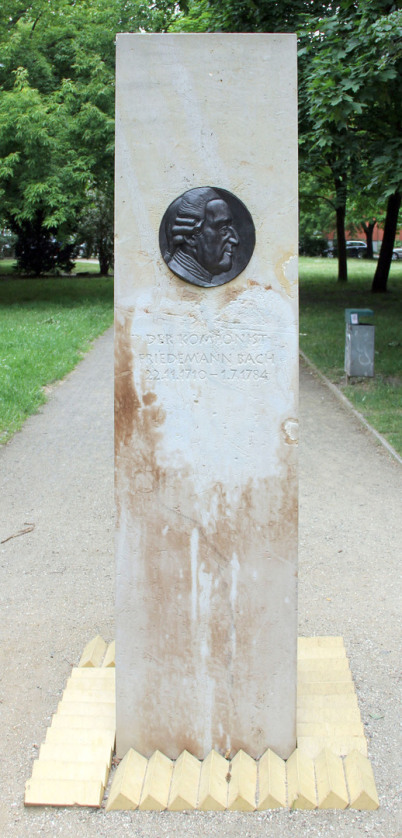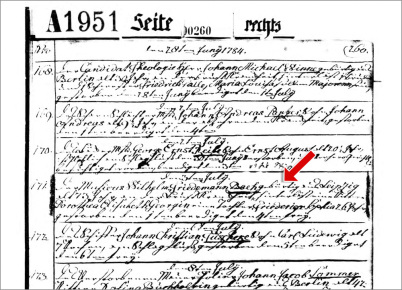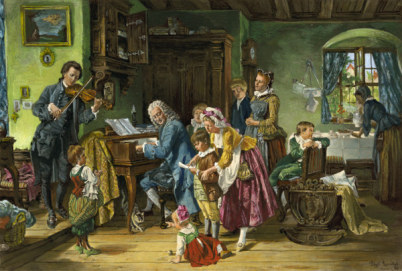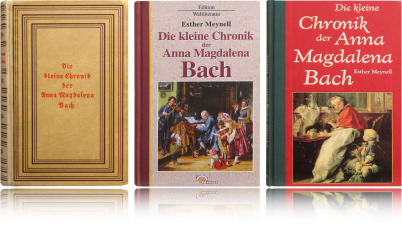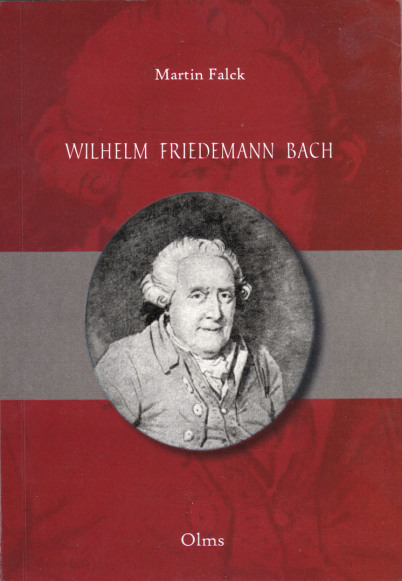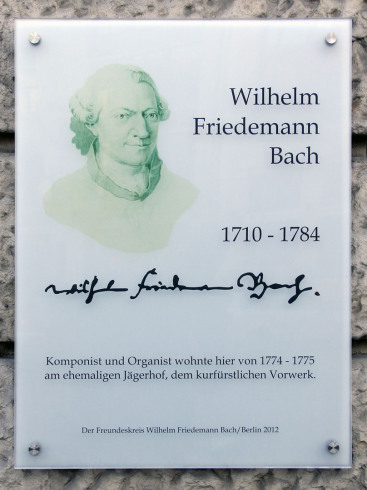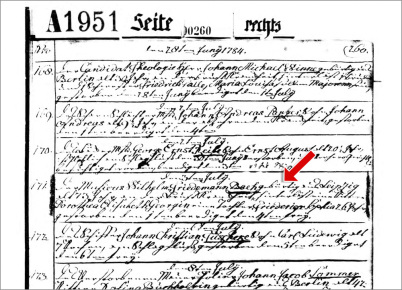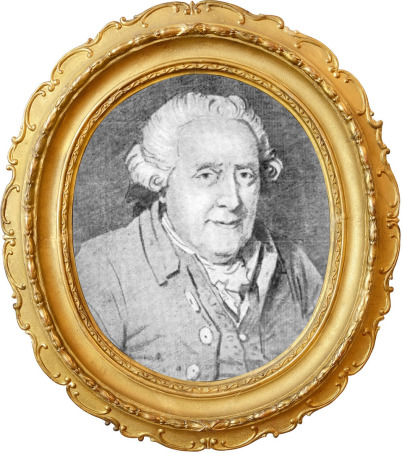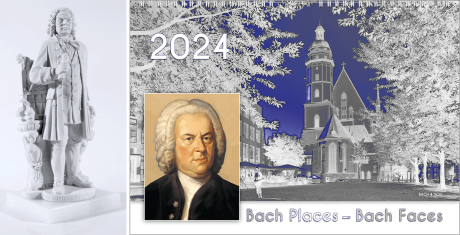Bach FAQ 116
Wilhelm Friedemann Bach, Bachs Son ... Was Wilhelm Friedemann Bach Really the Black Sheep in the Family of Musicians?
The 100 most important Bach FAQ.
No, no, no! Wilhelm Friedemann Bach was an honest person.
1. The first novelist Albert Emil Brachvogel really spoke very bad about Wilhelm Friedemann Bach. 2. Wilhelm Friedemann Bach ... the picture with "hat and fur"? That actually isn't WFB. But – and this is clearly scientifically clarified – a completely different Bach from the huge family of musicians from Thuringia. But ... it's just not Wilhelm Friedemann Bach.
The "Freundeskreis Wilhelm Friedemann Bach" (... the Circle of Friends of Wilhelm Friedemann Bach) in Berlin and in particular Gisela Thielicke as well as the Bach portal "Bach on Bach" and Aryeh Oron with his English Bach portal "Bach Cantatas Website" ...this "handful" of Bach enthusiasts has decided to "rehabilitate" WFB, as insiders call the oldest Bach son every once in a while. This is because both this image (... the man with the hat and the fur) remains so obstinate, and the novel by Albert Emil Brachvogel does the same. This realization – that the gentleman with the hat and the fur is not WFB and that the book by Albert Emil Brachvogel is just not worth reading – to spread these facts there, where they hopefully will be found more and more in the future – namely on the Internet, on Google and on "Bach on Bach", too – that is the declared way of these four hobby scientists in the matter of Bach. And ... that is the reason, why it is the FAQ 116 in our Bach mission. Related to Wilhelm Friedemann Bach. To the Wilhelm Friedemann Bach, who he really was. And to the pictures that show him how he really looked like back then.
Wilhelm Friedemann Bach? Yes, that's exactly Wilhelm Friedemann Bach. The "gentleman with the hat and the fur," who is, of course, not shown here: This guy is just not Wilhelm Friedemann Bach ... he has never been! And they know that for a long time already! Very long! But ... it seems so very exhausting to start to explain that crystal clear through a competent institution.
Advertisement
Music Gifts and More Music Gifts
Find out the difference between a European style music calendar and a 50:50 style music calendar … learn more.
✓
One of 99 music wall calendars and one of 33 composers wall calendars: three sizes, European style and US style. 2024 + 2025. To the shop. ✓
End of Advertisement
If you are so enthusiastic about this topic that this whole website page isn't enough for you, then you should contact the Circle of Friends of Wilhelm Friedemann Bach (Freundeskreis Wilhelm Friedemann Bach) in Berlin-Mitte. Call Mrs. Thielicke. Her phone number? Here you are: 0 30 - 8 52 64 23. However, check on the time difference and please don't call her in the middle of the night (CET; editor's note).
1. Wilhelm Friedemann Bach ... Who Actually Was Wilhelm Friedemann Bach? WFB ... Facts, Facts, Facts
Father of Wilhelm Friedemann Bach: Johann Sebastian Bach.
Mother of Wilhelm Friedemann Bach: Maria Barbara Bach.
Unofficial shortcut among Bach enthusiasts: WFB.
The number of brothers and sisters: 19, which never lived in this number at the same time.
Born: November, 22nd 1710.
Place of birth: Bach city of Weimar.
Date of death: July, 1st 1784.
Place of death: Bach city of Berlin.
Age: 73 years.
Profession: Musician and composer; late in his life one of the first self-employed musicians.
Description among Bach connoisseurs: The "Hallesche" Bach.
Married: to Dorothea Elisabeth Georgi.
The number of children: 3, but only one daughter grew up.
Working places: 1733 to 1746 organist at the Sophienkirche in Dresden. 1746 to 1764 music director and organist at the Marienkirche in Halle, Saale. In 1763 he was appointed Hessisch-Darmstädter Kapellmeister (band leader), but he did not show up at this position after the end of his employment in Halle.
Special features regarding his life and the time after that: The book author Albert Emil Brachvogel forwarded a very negative impression about Wilhelm Friedemann Bach, and he refers exclusively to his own fantasy. It is the only book in this Bach mission, which we really advise you insistently not to buy and not to read. There is a film about the life of Wilhelm Friedemann Bach, too with Gustaf Gründgens. This film is also based – almost naturally – on the trash of Brachvogel.
This gentleman on the board in a delicate green – you already saw him above – is Wilhelm Friedemann Bach. That is what he actually looked like! This remembrance in the form of a memorial plaque was initiated by Gisela Thielicke. She is the "driving force" in the "Circle of Friends of Wilhelm Friedemann Bach" and has been working for many, many years to ensure that the image of WFB will finally change again. And namely to the good. Since 2012, the memorial tablet is located precisely where the musician and composer lived in Berlin in 1774 and 1775. You find this memorial plaque in the quarter of Berlin, which is called Berlin-Mitte, namely at the Hausvogteiplatz on the corner of Oberwallstrasse.
1. Hints Regarding the Wilhelm Friedemann Bach Facts
The vita of Wilhelm Friedemann Bach – kids in Germany actually use the term of "warrant" for what English-speaking children use the term "facts" – The very short summary above was such a "Steckbrief", such a "warrant" ... almost not possible to explain that better. Funny? Funny! The "warrant" of Johann Sebastian Bach, the "warrant" of Anna Magdalena Bach ... and so on and so on. The vita, the short biography – the one regarding Wilhelm Friedemann Bach – is what you got here and now. The WFB vita to the point. By the way: In the USA, the same result is not what you find if you google "warrant plus name" and it took me months and many interviews with our American friends to figure out what's the same result, when kids in America google, checking on the crucial facts (... now I know) about a person. As I said, ...it is "facts"
This is Wilhelm Friedemann Bach, too ... on the stele in Berlin to honor him. You find it in one of the green areas in Berlin: it's in Berlin-Mitte, too (... like the plaque; Berlin-Mitte is the name of a district and does not mean the middle of Berlin) at the corner of Alte Jakobstraße and Sebastianstraße. Wilhelm Friedemann Bach is also shown "correctly" – just authentic – in the picture above. And that is since 2002. Two more persons are honored with this stele, and they remind of the Luisenstadt Church in Berlin, which used to have two completely different names in the past.
From today's point of view the first honor for Wilhelm Friedemann Bach ... the one in Weimar. Here was the house located, in which WFB was born as the first son and as the second child of the Bachs from Eisenach. Below you may discover in two pictures how that place was looking, what today is a parking lot with a wall around. Plus, you can see the "big picture" with the Johann Sebastian Bach memorial, which you almost miss today, if you do not search for it.
In fact, on this old postcard with the Lucas-Cranach-Haus on the left, you can still see the birthplace of Wilhelm Friedemann Bach and Carl Philipp Emanuel Bach. Exactly behind the fountain is the "Hotel Elephant", whose owners adorn the parking lot behind the wall with the first tribute of Wilhelm Friedemann Bach. So, here WFB is born. If you know Weimar, this picture is certainly very exciting for you. If you do not know Weimar, it's just not that exciting. But if you travel to Weimar soon, on the traces of the three masters Johann Sebastian Bach, Carl Philipp Emanuel Bach, and finally, and most importantly for us, Wilhelm Friedemann Bach, just print this little historical picture prior to your trip and take it with you.
Plus you get a historical bonus photo, as we found two in our archive when we were looking for just one. Do you see the little canopy at one of the houses on the right side: It is that house. In the middle of the pic, in the background, you see the Red Palace, the Rote Schloß.
Weimar is "so full" of culture that there is no interest at all in honoring even three musicians of world-class with a museum or a similar place. Three? Sure: First of all, Johann Sebastian Bach, later Wilhelm Friedemann Bach and finally the third famous musician of the family: Carl Philipp Emanuel Bach, second famous son of Johann Sebastian with Maria Barbara. Well, maybe the Bachs simply weren't long enough in Weimar to deserve a monument that reflects the world-class of these musicians and this family of musicians. It had been "only" nine years. The arrow points to the wall of the former house in which the Bachs lived back then (... a picture further up you saw the plaque on just this wall). The monument for Johann Sebastian (... in this picture) is so tiny that it has "disappeared" behind one of the trees. But there is a compensation: You get a next photo below.
At least the Johann Sebastian Bach monument is not in "garden gnome size" and nobody has to bend down, to admire Bach. And there is one good thing coming with the manageable size: You can easily wipe spiderwebs out of the face of the master ... I mean before you make a photo of him. The Bachs, by the way, lived exactly vis-à-vis of the Red Palace (Rotes Schloß) and 20 steps away from the town hall.
If you have studied to take pictures, you are able to take pictures of cute teeny tiny miniature monuments and make them impressive "valuations". You just have to approach him a little bit closer, homage him from the bottom to the top, and, as already mentioned, wipe the cobwebs from his face, first. Then it works well with J.S. Bach, too.
Advertisement
Music Calendars and More Music Calendars
✓
... and again the daddy of Wilhelm Friedemann Bach. But that should be enough now! However, quickly back ... to Wilhelm Friedemann Bach, because his father plays on this page just the "second violin".
2. The Wilhelm Friedemann Bach Short Biography: So, ... Who Actually Was Wilhelm Friedemann Bach?
It was in 1710 when Wilhelm Friedemann Bach was born as the second child of Johann Sebastian Bach and his first wife Maria Barbara Bach in Weimar. It was November, 22nd 1710. He was the first of five musical sons of Johann Sebastian Bach. Two of them even gained more recognition and fame in their time than the superstar of the Bach family, Johann Sebastian Bach, did in his time. In fact, Wilhelm Friedemann Bach was born exactly in the house vis-à-vis the present Red Palace in Weimar, almost in the neighboring house of the still existing "Hotel Elephant" in the city center of the cultural metropolis. Of course, Wilhelm Friedemann received the first music lessons from his famous father. At the age of seven, he moved with the Bach family to Koethen.
In Koethen Wilhelm Friedemann attended the Latin school. At the age of 13, he finally went to the Thomas School in Leipzig, when the Bachs had moved again. It is known that at the age of 17 he received violin lessons from Johann Gottlieb Graun and he studied law, philosophy and mathematics two years later, namely 1729. At the age of 22, he first became an organist at the St. Sophias's Church (Sophienkirche) in Dresden. In April 1746, at the age of 35, he became the music director and organist of the St. Marie's Church (Marienkirche) in Halle on the Saale, where he also directed the school choir and the municipal choir. That is why he is called the Hallesche Bach. In 1764 he ended this office in Halle, now at the age of 53. From this day on, he lived the life of a free-lancing musician, one of the first in this still unfamiliar form of employment at all, but especially in the field of music. This time, until his death in 1784, that is, at the age of 73, had to be completely re-evaluated 230 years after his death. Read much more about it below. Wilhelm Friedemann Bach was famous for his improvisations as an organist and as a pianist. Like many a piece by Johann Sebastian Bach, many works by Wilhelm Friedemann were long forgotten. In Kiev, many of them were found in the inventory of the archives of the Singing Academy Berlin ((Sing-Akademie Berlin). The world owes this find to the Bach connoisseur, Bach author, and Bach scientist Professor Christoph Wolff. In 2010 the Leipzig Bach Archive published a complete documentation in 11 volumes.
Wilhelm Friedemann Bach married 1751. He married Dorothea Elisabeth Georgi. Both had three children, two of whom died very early. Only Friederica Sophia Bach grew up. Wilhelm Friedemann Bach died in 1784, and an obituary was written in the "Magazin der Musik" (... magazine of music): Germany lost its first (best) organ player and thus the world lost a man who is irreplaceable as a musician. It is interesting to note that today Johann Sebastian Bach, the father of Wilhelm Friedemann Bach, is considered the best organ player of all time.
Wilhelm Friedemann Bach? Yes exactly. Wilhelm Friedemann Bach. But where is the hat and the fur collar and: the fancy glove, too? We apologize for any inconvenience: not on this page of my website! And as well not on the whole website. This page about Wilhelm Friedemann Bach – on which you are currently reading – has exactly two goals. First of all, we want to inform you about this music expert. And that's right on Google page (... in the future) 1. But ... we also want to clarify two things as well: Wilhelm Friedemann Bach never looked as he is still (... it is the year 2016) so often portrayed on Google. Namely exactly 31 times with black hat, fur collar and a glove in the paw. And – in addition – Wilhelm Friedemann Bach had never been the personality, that Albert Emil Brachvogel had described a really long time ago. The "Freundeskreis of Wilhelm Friedemann Bach" has been working on these three areas for around 20 years.
3. The Wilhelm Friedemann Bach Biography. Up-to-Date, Fair, and Above All: Correct!
Dr. Ulrich Kahmann. On a whole different path compared with the efforts of Gisela Thielicke and that one of our Bach mission, this book author rehabilitates the first of the Bach sons, namely Wilhelm Friedemann Bach. He accomplishes it with his biography about the musician. A cordial correspondence with this specialist on the subject of WFB and his help in various forms, lets me, the author of this my website, present the book author Dr. Kahmann exactly here. Isn't that covered advertising?
Nope, it is not. He is just the perfect author on the subject. And almost nowhere else you can get better and more detailed information on the topic "Wilhelm Friedemann – How he really was". This, by the way, is not the subtitle of his book. So it is no covered advertising here ... but proper advertising. For his book. For a common theme. For your orientation. And now comes the ultimate service: you get to Kahmann's book about Wilhelm Friedemann directly via the following link. And if you order the top work directly at the Aisthesis Publishing House, the team around the publishing house and the author is the most pleased. Oh, you wanted to know the exact title? Here it is: "Wilhelm Friedemann Bach – The Underestimated Son". One fly in the ointment. It's in German only. Sorry, folks.
This is how the author looks. Author of "Wilhelm Friedemann Bach – The Underestimated Son": Dr. Ulrich Kahmann. His book was published by the Aisthesis Publishing House in 2010. This is our ultimate recommendation when you want to get to know the first son among the four composing Bach children – who, like two other siblings, was born in Weimar. Of course, then with the correct picture on his book cover, not the Weitsch picture, from which the world can not free that easily. And, of course, Kahmann writes in a German that is spoken today and not in the 1913 counterpart, when Martin Falck began the common WFB mission some 100 years ago.
In Our Bunch the Fourth
Five musicians were among the children of Johann Sebastian Bach. One of them is considered the "Enfant terrible" of the four well-known and two famous Bach sons today. This was absolutely not the case in the 18th century. We owe the Aisthesis-Verlag (... Aisthesis Publishing House) and Dr. Ulrich Kahmann that you may inform yourself about Wilhelm Friedemann Bach today in an exciting and, above all, young work – in a German, which you speak today. Dr. Kahmann's work is released in the mentioned Aisthesis Publishing House a very short time ago ... measured at the ultra-long time since Wilhelm Friedemann's birth. So this book is so fresh that you can almost still smell the printing ink.
Why Dr. Kahmann gets such a prominent place on this, our page about the oldest of the Bach sons? Well, this is because in the beginning – in the first version of this page – he had not been mentioned here at all. However, Gisela Thielicke (... I will present her impressive life performance in the subject "Wilhelm Friedemann Bach" below) wrote to me – when she read about our common project on this page – that I absolutely ( ! ) should mention the book of Dr. Kahmann and his enormous performance. What I had not yet done. I wanted to do that of course, and because Dr. Kahmann supported me so heartily, promptly and firmly in the matter of "Wilhelm Friedemann Bach", I thought that with his publication, he was one more combatant – even earlier than I – to get involved for the truth around the oldest of the Bach sons. So now we are four meanwhile: Gisela Thielicke, Dr. Kahmann, and we 2 Bachs, with our common "Bach mission", too. And ... of course, Dr. Kahmann was "on Wilhelm Friedemann's side", long before we – the author (... I ...) of this website and his (my) wife – finally followed in 2016. Just Gisela Thielicke ... she was there even earlier.
And with the following text the publisher presents the work of Dr. Ulrich Kahmann (... admitted, the text is a little (violent) edited by me; note by Peter Bach jr.): Of the four well-known sons and the five musical sons, the firstborn son of Bach has long been regarded as the "enfant terrible ": Wilhelm Friedemann Bach. Already in the time of Johann Sebastian Bach, he as a composer stood in the shadow of his younger brother Carl Philipp Emanuel Bach. However, he became famous by the unmusical and untrue report about his life. In 1858, Albert Emil Brachvogel made him well-known and he stylized him as a vagabond. In a novel. The author Carl Hermann Bitter finally achieved the disadvantageous reputation of Wilhelm Friedemann Bach – exactly ten years later – when he marked him down a further step: he made him the wayward son of the gifted Johann Sebastian Bach. And so until the present day, the reputation of a failed genius is still attached to him. A genius, however, who finally had lost his fight against alcohol in a fogging and died completely destitute as one of the first independent musicians.
Advertisement
Music Calendars and More Music Calendars, Bach Gifts and More Bach Gifts
Please support our Bach Mission … learn more.
It's the music calendar publishing house "Bach 4 You", where you find so many music calendars in two styles … learn more.
✓
End of Advertisement
700 Biographies About JSB – But There Are Just a Handful Biographies About Wilhelm Friedemann Bach
Yes, I would have been able to come up with a list of publications on Wilhelm Friedemann Bach. But I did not. And thanks to Dr. Kahmann: he did not just remind me, he also added the list right away. Just a little, I arranged it regarding their publication date and how good, there is not biography after biography, as it was the case with the daddy of Wilhelm Friedemann.
Unfortunately, unfortunately, the list starts with the "work" of Albert Emil Brachvogel, but he does not get a hyperlink here. Of course not. It was in 1858 when he invented this jabberwocky regarding the oldest of the Bach sons. Carl Hermann Bitter continued Brachvogel's campaign against the poor Bach son, and that was exactly 10 years later 1868. He does not get a link from us here, too. Not for this. Heinrich Bellermann was the third in this nineteenth century, further seven years later – 1875 – who continued the publications about the oldest of the four composers, who resumed the Bach family tradition. Whether this was also negative in the tradition of the two mentioned authors above ... or whether he was the first of the repairers (... is there such a word?), is what I want to clarify in the year 2020 – if I have time to read again then – and then I mention the result here.
More than 75 years the novel by Brachvogel had "silence", to spread its content evenly over the Bach interested world, because even when Bellermann already began – which we still do not know – to publish about the life of WFB correctly ... he did never accomplish the popularity which the novel by Albert Emil Brachvogel had.
In 1953, Wilibald Gurlitt wrote about Wilhelm Friedemann. In 1964, Hans Franck joined the mission with his – little known, but joyously unprejudiced title – "Friedemann". And Percy M. Young devoted the chapter 9 in his work "The Bachs" to him. That was in 1978. In 1990, Friedrich Wilhelm Bautz followed and in the 3rd millennium finally, a creative title is published finally: Michael Heinemann adds to his biography about Wilhelm Friedemann the supplement "The battlesom son". This was back in 2005.
David Schulenburg was the next to publish about the musician from Weimar. Last author but one was Dr. Ulrich Kahmann and he added "the underestimated son" to the name of our hero WFB ... his book is the one, which we recommend to you – and we are Mrs. Thielicke, my wife and I – we recommend it as a very special book about the Bach son. In the same year, Kahmann published "A Wrong Picture of Wilhelm Friedemann Bach", too and that is in the "Tonkunst", a magazine related to classical music.
The last author regarding the theme is finally Daniel Hensel and for that reason, his work is the youngest about WFB. It's, by the way, the perfect addition to Dr. Kahmann's biography, because while Kahmann explains more about the life and the legacy of the first Bach son – and doesn't care about the musical details too much – this is what Daniel Hensel is doing: he delivers with his text important new insights in the compositions of Wilhelm Friedemann Bach.
So, exactly on the 300th birthday of the composer and musician Wilhelm Friedemann Bach in the year 2010 another biographical study, namely the book of Dr. Kahmann, contradicts this version that we have about Wilhelm Friedemann Bach by Brachvorgel and Bitter: Wilhelm Friedemann Bach was a driven man, who not only had huge problems with the gigantic shadow of one of the most famous musicians of all time but was as well challenged by the situation to find the perfect musical place in the back then transition period from the late baroque to the back than modern classic.
The biography about Wilhelm Friedemann Bach of Dr. Kahmann is probably the fourth which came into being after the work of Martin Falck, who – with his biography about the Bach from Halle (... the Hallenser Bach) lay the foundation for the fair and correct classification of W.F. Bach. 100 years after the first approach 2010 followed an exciting rectification.
Dr. phil. Ulrich Kahmann is an independent author and has specialized. His area of expertise are portraits of musicians, which he primarily produced for radio stations. Dr. Kahmann is living in Herford, Germany, and he teaches at the University of Klagenfurt, Germany other institutions and the music scientific seminar at the University of Paderborn, Germany. Okay, that's a short information about the work and the person behind. Here is the link to the book again: "Wilhelm Friedemann Bach – The Underestimated Son" by Dr. Ulrich Kahmann, published in the Aisthesis Publishing House.
Honor to whom honor is due. Without Gisela Thielicke from Berlin, the so-called Weitsch-Painting (... the man with hat and fur and glove) and the garbage from A.E. Brachvogel would even in the third-millennium transfer this nonsense to our children and grandchildren. The researcher, we from "Bach on Bach" and Google want to try, whether we can't change that. Long live Wilhelm Friedemann Bach.
The Biography about Wilhelm Friedemann Bach ... But Please Not by Albert Emil Brachvogel
Honor to whom honor is due. Without Gisela Thielicke from Berlin, the so-called Weitsch-Painting (... the man with hat and fur and glove) and the garbage from A.E. Brachvogel would even in the third-millennium transfer this nonsense to our children and grandchildren. The researcher, we from "Bach on Bach" and Google want to try, whether we can't change that. Long live Wilhelm Friedemann Bach.
The Biography about Wilhelm Friedemann Bach ... But Please Not by Albert Emil Brachvogel
The review of several Bach enthusiasts and also of serious researchers and of hobby scientists regarding the book of Brachvogel? Rubbish, rubbish, rubbish³. Would you like to get that confirmed from a scientific point of view and without any moonshine? Then please read the next chapter.
Wilhelm Friedemann Bach - The Reevaluation of His Personality
From the music magazine "Der neue Merker", written by music critic Helmut Batliner, Vienna, April 2nd, 1998. Here the copy from the newsletter number 2 of the Circle of Friends of Wilhelm Friedemann Bach, Berlin from November 2010.
In 1858, Johann Sebastian's oldest son became a "novel hero". The book "Friedemann Bach" was published by Albert Emil Brachvogel which are read in many editions up to the present day. His content was the basis for an opera by Paul Graener (1872 -1944) in the 1940s the last century this was the foundation for a UFA film with Gustaf Gründgens in the title role. The book, the opera, and the film have contributed destroying the overall personality picture of this exceptionally talented musician. Brachvogel's dedication in the second edition of 1859 is: "To His Royal Highness, Carl Alexander, Grand Duke of Saxony-Weimar-Eisenach, and Her Royal Highness, Sophie, Grand Duchess of Saxony-Weimar-Eisenach, née Princess of the Netherlands, the sublime friends of art In the most profound reverence devoted from the author, "and a book so devoted to" high personalities "can not be bad at all.... But this writer was only prepared to portray Johann Sebastian's most beloved son as the disapproved son. Friedemann was not the lump, stating father's compositions as his own, he was not the described bourgeoisie, the unrelenting fool, or the periodic drunkard. Not one single word regarding the love affairs at the Dresden court is true.
Sure, if a first author is devising real garbage, why should the next author think about it again?! Like the book, so is the opera an in the same way and of course ... was the film.
We did not take the easy way out. Should we present this "gentleman" ... or shouldn't we present this "gentleman" here? He definitely did not deserve it. But: maybe Google helps us to excite more and more people to read here about Albert Emil Brachvogel, whom you "may" call A.E. Brachvogel, too. He is practically the Roland Emmerich of his time, just a negative version. At that time back then they did not even think of extraterrestrials. So one last time: You owe this page to him! To Albert Emil Brachvogel. Please do not buy his book! By the way: Emmerich is really cool and nice.
Further on with what we would call a "right of reply" today (Editor's note):
The following quotation might shed some light on the ability to make inventions of this gentleman, in which an officer is said to have made a trip with Father Bach to the Fortress of Koenigstein in order to pick up Friedemann, who had been imprisoned for an affair with the Countess Kollowrat: "That he was sitting on the Koenigstein, Is certain, the coachman has told me definitely that he has driven him to that place. " At the same moment, they heard distant voices and the clanging of weapons. "My son, my son! ... Friedemann! " A roar, a shrieking sound, answered him, and from the circle of the soldiers the son rushed toward his father. "Hi, hi! So funny in the moonlight? – Hahahahaha!" Sebastian had his son again, but he was insane!!
The signature of Wilhelm Friedemann Bach.
In the second volume, Friedemann recovered reportedly thanks to loving care by relatives, and you wonder when reading the book, who was insane. If Brachvogel had undertaken diligent preliminary studies on this personality, and not had just written down untenable ideas, a more true picture would have emerged. The sequences in which Father Bach had to give concerts for the king and the nobility showed empathy and convincing. He also let the father say that Friedemann "... would never make it!" What should he accomplish? Friedemann was musically too well-trained, and he himself recognized how immense the artistic shadow of the father was; He also knew that he could not "get over it" and had different, maybe even new ways to go. The "sublime friends of art" and all readers for140 (... meanwhile 160, a note of editor) years have been echauffiert and very surprised to read of such a quirky artist existence. In his unrestrained and irresponsible scribbling, this man has not condensed of the so-called biography but has condensed everything. This assertion may also be maintained if you not only know that Friedemann was not a lump, a fright and drunkard but just as little an exemplary citizen, a proper church official, and an anti-alcoholic. But there are worlds in between facts and emotions.
3 pictures ... then the text goes on (Editor's note).
It has been around 100 years since one author wrote about Wilhelm Friedemann Bach, who really knew about what he wrote: Doctor ( ! ) Martin Falck. You can buy this little book starting at € 14 today. On Amazon. For example. It's a pity ... it's only in German.
Wilhelm Friedemann Bach, somewhat younger (... a very heartfelt thanks to the director of the Bachhaus in Eisenach, for permitting to show this picture here) ...
... and Wilhelm Friedemann Bach, a little older.
Advertisement
Music Calendars in Two Styles ... Which Store Has a Larger Variety of Bach Gifts?
Please support our Bach Mission … learn more.
In 1913, Martin Falck developed these differences scientifically in a dissertation and gave Friedemann's known works until that day works numbers (Sinfonia f major, Falck 67, "Dissonant Symphony"). The doctoral thesis shows that Brachvogel's book is a fake from the beginning to the end in everything regarding Friedemann. Dr. Falck did not experience the second edition of his monograph – which emerged from the dissertation –in 1919 since he fell in World War I (... a third edition was published in 1956 by Kahnt Publishing, Lindau, Germany). His work is deliberately in severest contrast to Brachvogel's book and accepts only flawlessly documentary facts.
With the help of this fundamental work and his own studies, Hans Franck designed a biography entitled "Friedemann" (... published in 1964 in the Kreuz Publishing House, Stuttgart, Germany and you can still find his book in second-hand bookshops), in which he re-created the life and work of Bach's son through genuine compassion: he does not act as an "inventor", but as a finder, he does not intrude but tries to be an "interpreter". Friedemann Bach dominated the baroque style as hardly any other musician, but he was equally enthusiastic about new sounds; his musical superiority often made him switch between new and old, which irritated his contemporaries. They admired his harpsichord and organ playing, but above all, they were enthusiastic about his improvisational art. They were often at a loss for the production of sound creativity. In the "Berlinische Nachrichten" (Berlin News), which are the "Berlin News" you were able to read about a concert of him in 1774. "Everything that impresses the perception, novelty of the thoughts, striking evasions, dissonant sentences ... offered the image of a superior master. A transitional phase, in which taste and requirements changed rapidly, also allowed the harpsichord with its limited expressive possibilities to give way to the piano. His liberation was so great that he refused – as later Beethoven – ordered concertos, and that is true in the 18th century. It was his self-confidence, too – he was ahead of the time – made him the first free-lance artist in a "networked" time. This "professional image" did not exist at that time and made him, in the eyes of his contemporaries, the idiosyncratic son of the great Bach father, who himself gradually fell into oblivion, too.
There's more text below the "Piano Booklet for Wilhelm Friedemann Bach" by his father Johann Sebastian Bach(... editor's note).
Sure, this should not be missing on such a page like this: the "Clavier-Booklet for Wilhelm Friedemann Bach" (... the piano booklet for WFB). From daddy. For learning, for practicing and for this website page, some 300 years later. It's that far ahead, that the super Bach thought this website coming back then. Thank you very much, J.S.!
A copy of Wilhelm Friedemann's concert in F minor (Falck 44) finds its way to back than former student Sara Itzig, married Levy from Berlin, which later became the grandaunt of Felix Mendelssohn Bartholdy. Maybe her are the roots, which made the reproduction of the forgotten "St. Matthew Passion".
After a pneumonia Wilhelm Friedemann Bach died in 1784 and left his wife and his daughter back in poverty.
As an obituary you were able to read in the back then "Cramer's Magazine of Music": "Germany has lost his first (best, back then) organ player and the musical world a man in general, whose loss is unreplaceable."
Only very few compositions of Wilhelm Friedemann Bach were printed, however, there were many copies around. It was possible, that one of his copies (Suite g minor for cembalo, 2 violins, viola, cello, bass) just carried the name of "di Bach" and for a long time it remained a piece of which they thought it's a work by Johann Sebastian (BWV 1070), what meanwhile turned out to be wrong. Mozart's studies of music from Bach and Handel lead to editings of fugues from the "Well-tempered piano" (... for violins, viola, and cell), but of the 8th fugue, f minor of 8 fugues, as well, which was dedicated to the Princess Amalie of Prussia for cembalo. It is said that Mozart place own adagios in front of these Bach fugues, which is not proofed because there are no handwritings existant (... however, they sound exquisite) The preserved and published on CD works of Friedemann are filled with a wealth of phantasy and feelings, rousing expression and lyric feelings in slow sentences, however he perplexes with brave harmony, too.
Wilhelm Friedemann Bach was buried on the cemetery at the then Sebastian Church, later it was called Koellnian Suburban Church, and from 1802 its name finally was Luisenstadt Church. He died completely impoverished. And that is what the church looked like before it shared its fate with many historical buildings in World War II after one of the bombings.
With the demolition of the ruin of the Luisenstadt Church, the memory of Wilhelm Friedemann Bach firstly disappeared, which previously reminded of the musician in the form of a plaque.
The Circle of Friends of Wilhelm Friedemann Bach in Berlin Since 1998
It is the year 1998. That far back there are the plans, in honor of the musician Wilhelm Friedemann Bach, to establish a circle of friends, who sees its statute to rehabilitate the gifted composer and pianist Wilhelm Friedemann Bach sustainable and get in contact to as many publicists as possible to convince them to replace the image that shows a "gentleman with a black hat and with fur collar and glove" from their works. And to replace it with an authentic portrait. In 1998 the decision was made to establish such a circle of friends. In addition to Gisela Thielicke in Berlin who is still actively interested in this goal, there were the first-time contestants Klaus-Norbert Kremers, Krefeld, Germany and round 10, later 150 more enthusiasts.
Already before 1998, there was a Citizens' Association Luisenstadt e.V., which had the intention in 1998 to erect a memorial on the place of the Luisenstadt Church, destroyed in World War II. The pastor of the Luisenstadt Church at that time was Peter Storck and he was who informed Gisela Thielicke about that plan. Three personalities were buried on the then cemetery: Wilhelm Friedemann Bach, Friedrich Nicolai, and Karl Gottlieb Suarez / Svarez. As a sculptor for this memory they could inspire Nikolaus Bode. Dr. Frank Eberhardt was at that time the long-standing chairman of the Bürgerverein Luisenstadt (... Citizen's Association Luisenstadt) . He died in 2001. In 1999, the Circle of Friends brought the plans to the Bach Archive.
Below the picture, we go on with the text (Editor's note).
A first real huge success to remember a musician who – though in the shadow of his father – was an excellent musician and composer. A memorial that remains of the Luisenstadt Church and to three personalities: Friedrich Nicolai, Karl Gottlieb Svarez and just ... Wilhelm Friedemann Bach. The "Wilhelm" in Bach's name did not make it onto the memorial, but ... we do not want to be petty. And – here it is explicitly mentioned – the Bürgerverein Luisenstadt e.V. earned a huge thank you because this society had begun the whole initiative back then. Again the address? My pleasure. It is located in Berlin-Mitte, in the green area at the corner of Alte Jakobstraße / Sebastianstraße. At this point, we would like to thank the Stiftung Stadtmusem Berlin, which presented this excellent picture in memory of the composer and musician on the internet. It shows the historic memorial plaque at the Luisenstadt Church. By the way, you can visit the website's cool website by clicking on the link.
A charity concert took place in the St. Jacobi Church in Berlin-Kreuzberg in March 2001, around 1½ years later. The musicians were – in line with the event – the Friedemann Bach Orchestra conducted by Oliver Lüsch.
In the autumn of 2001, the work meetings were held for the production of the memorial stele. In spite of the effort to publish and convey the right information – especially in the subject of Wilhelm Friedemann Bach – the Circle of Friends failed to present Bach's second essential first name. More success was given to the Circle of Friends by choosing the portrait of the medallion after P. Gülle, and the orientation of the plaque towards the view of the church could be realized.
The new monument was finally inaugurated with even two celebrations.
Exactly on September, 7th 2002. Initially the inauguration of the stele in the green area at 4 pm. Of course, again, the Wilhelm Friedemann Bach Orchestra made music, again conducted by Cantor Oliver Lüsch. A further charity concert in the church at 6 pm concluded the festivities on this day. On November 7th, for the first time, it was also possible to draw public attention to the Circle of Friends of Wilhelm Friedemann Bach: On the occasion of a speech in the URANIA in Potsdam. A second opportunity arose shortly after when Gisela Thielicke was studio guest at the ORB in Potsdam: "Märkische Zwischenentöne, which is Mark Brandeburg shadow tones" – sort of – was the format, the "Wilhelm Friedemann Bach Society" was the theme. By the way, the ORB Potsdam was at that time the forerunner of today's radio station "rbb", which is Radio Berlin Brandenburg.
Wilhelm Friedemann Bach. So ... is how we wish his distribution on the Internet. That is what Wilhelm Friedemann Bach really looked like.
If there is an authority in the subject of Johann Sebastian Bach and probably also around the Bach family of musicians, too, then it is Harvard professor, Bach scientist, Bach expert, and Bach author Professor Christoph Wolff. With his letter from 2012, which was addressed to Gisela Thielicke of the Circle of Friends of Wilhelm Friedemann Bach, it is confirmed by the most competent authority: "Man + Hat + Fur + Glove" = Weitsch painting = not Wilhelm Friedemann Bach. It does not get any clearer. Now all that remains is to "eradicate" this "Weitsch painting" a bit. This is not completely going to happen, because this painting just portraits a Bach. Just not ... Wilhelm Friedemann Bach!
We Urgently Need Your Help, Please!
Please help us: In the coming 50 years, we want to adjust two things with a lot of drive and commitment!
Please help, if you are especially interested in Wilhelm Friedemann Bach. First, a cordial second request: Please do not use – please never ever – the picture of Friedrich Georg Weitsch: the gentleman with a black hat, fur collar and one glove in his right hand. Because it is just not Wilhelm Friedemann Bach. Even many years ago, this was confirmed by the honorable Bach Archive to the Circle of Friends of Wilhelm Friedemann Bach, namely in a letter from the board to Mrs. Thielicke. There are three pictures of WFB, use these portraits and help to make sure that one day the story will disappear, even in the time of the Internet, where one author copies from another author and this author of his predecessor.
To attribute the "wrong picture to the right Bach son" has at least nothing to do with evil intentions or really much stupidity or wickedness. This is different, however, with the most famous book on Wilhelm Friedemann Bach. Right, the "work" of Albert Emil Brachvogel: This novel – indeed correct, this trash is indeed declared as a novel – it represents Wilhelm Friedemann Bach in a very bad way and makes him bad in every description. Albert Emil Brachvogel was born in 1824 in Berlin. This was exactly 4 decades after Wilhelm Friedemann Bach died in Berlin.
Wikipedia writes, Brachvogel was a writer, but he was a full-time dramaturge, and he actually wrote only two important works. One of all books became a bestseller based on fantasy. He built a story about the oldest of the famous Bach sons and published this story in the way of today' the really worst sense of the so-called "Yellow Press".
Invented? Yes, invented. Not only his "novel" became a bestseller and it sells up to the present, but in 1931 it also disoriented interested people in an opera with that title. The highlight of this process is finally the film "Wilhelm Friedemann Bach" in 1941, entirely in the style of Hollywood, which was filmed with Gustaf Gruendgens. One can not imagine how you could harm a person more – posthumously – than with such a silly story. Maybe Brachvogel thought that you might be more likely to succeed offside the truth after he himself failed as an actor and the first book was also a purge. He even became Freemasonry later. Even their secretary of the so-called "Grand Landloge of the Freemasons of Germany in Berlin."
And so, Albert Emil Brachvogel is virtually responsible alone today for the fact that Wilhelm Friedemann Bach is portrayed so dramatically badly in history. By the way, that his novel and his portrayal of Bach's son is without any correctness and is simply fictitious is, of course, is neither my opinion nor that of the Circle of Friends of Wilhelm Friedemann Bach in Berlin.
Dr. Martin Falck, who had just experienced the publication of his work in 1913, researched it all. Because he fell shortly thereafter – in World War I. "The abortion of calculating mind", this serious author has named the smear of Albert Emil Brachvogel. He also denied him any qualification at all. And that is although there were sources in which Brachvogel could have researched. The author of these lines – that is, I (... the author of "Bach On Bach") actually had real scruples to present Albert Emil Brachvogel on this page in a picture. In the conviction that he looked like in the pic. Definitely, Albert Emil Brachvogel did not deserve it.
Well ... on the other hand, Brachvogel did not spread the picture of Wilhelm Friedemann Bach with a black hat and fur collar. This is the responsibility of others. Now I would like to split you – dear surfer, visitor or reader currently researching in the matter of Wilhelm Friedemann Bach – in one of three groups of interested people. Either you are already satisfied with the profile, the facts or a short biography, then do not read this following here. But if you are at least one interested person "the second category" and you are interested in learning more about Wilhelm Friedemann Bach and you find it exciting to be sent on the right path by a "miniature circle of hobby experts", because you would like to buy a real detailed description of the life of Wilhelm Friedemann Bach ... new or used ... then you are still here.
If this is indeed the case, that you are looking for more information about the first Bach son, than please, please do not "Wilhelm Friedemann Bach" by Albert Emil Brachvogel. This is how you can learn more about Einstein's theory of relativity from a Mickey Mouse booklet than about WFB's life. With Albert Emil Brachvogel you just get a wrong impression. And you do want to learn more about the true life of WFB.
So, then you belong to the third category. You would even want to spend some money on your plans. In the third category, however, there is an exciting suggestion here: If you're a student or a very interested pupil or, a music lover or classic fan, then join our Circle of Friends. Here it is, namely is the book "Wilhelm Friedemann Bach" by Martin Falck, with a cute foreword from him about our muckraker Albert Emil Brachvogel (Brachvogel fans may forgive me, but to put WFB in such a really bad light, without need and just to gain the advantage of a good sale of the self-written book ... this requires some more violent words than the usual ones).
However ... if you are not part of the group of Wilhelm Friedemann Bach enthusiasts mentioned in the paragraph above, but you already make some money and you want to join our common request, then please buy the book, which is still published in the Olms Publishing House. On Amazon, this is for 14 € and in the Olms Publishing House directly for € 19.80. The publisher, who publishes it at its own risk, also wanted to provide a little justice for Wilhelm Friedemann Bach. In the hope that my WFB page sells a few more than the few sold copies, it would be a heartfelt thanks, if you could decide to help us, its contribution to the topic with the purchase of a copy. At least financially. Thank you very much.
Once more the complete stele of sculptor Nikolaus Bode, as it stands today in a green area, where the Luisenstadt Church used to be. In contrast to a picture above, here photographed in summer. Without the "Circle of Friends of Wilhelm Friedemann Bach" and without Gisela Thielicke, this honor would probably never get today's publication with this website page.
What You Can Find on the Internet about Wilhelm Friedemann Bach: But Please Do Not Read the Trash of A.E. Brachvogel
Of course, it would not have the desire – this Bach portal – to become the most exciting source of information about the Bach family of musicians, if there is no further information. First, the German National Library is a good place to learn much more about Wilhelm Friedemann Bach. In the German Digital Library, you find out more about the works of and about Wilhelm Friedemann Bach and on Wikipedia Commons / Wilhelm Friedemann Bach ... there is a collection of videos, audio files, and pictures. Sure, even there you meet this false image of the musician. We hope we can change that: What about if you try out whether we accomplished that goal? With a click here.
The death entry regarding WFB. We would like to name a very small, really tiny little mistake here, but we will soon overlook it quickly and generously: Wilhelm Friedemann Bach was not born in Leipzig, but in Weimar ... so much is also safe!
From Rentsch and Ihle to Haußmann. And from Albert Emil Brachvogel to Esther Meynell
So? Who is Wilhelm Friedemann Bach? Sure, it's a catch question. For Tobi Edward Rosenthal, of course, did not know how all of the Bachs actually looked. But probably ... Wilhelm Friedemann Bach is the young man on the far left.
Sure, yes, it is permissible to write novels about people and it is just as okay to invent images of people as they would never have ever looked like in their lives. This is legitimate, is done and is consumed, in the case of pictures just looked at, just read in the case of novels. But there are limits. The producers of "War of the Worlds" in 1938 had to experience this as a great defeat when they aired a report about the landing of extraterrestrials in the US as a radio play. Although the product was defined as a fiction before – but who is listening to so many things right now – panic broke out and only later they became aware of how easily people believe in a superficially used "story". The lunar landings, King Ludwig's death in the lake and Area 51 leave their greetings. But there are limits for similar situations, too. It is about early forms of insults and about what responsibility you take to bend history. And this with intent, with low motives and everything in an ugly form. Many artists have made use of Bach's imagination. There are several dozens of "J. S. Bach" paintings that represent him, as he never looked. The one "portrays" him kindly, the other seriously and vigorously – probably because the story thus depicts him – and again others do not value his personality with their works of art at all. Even most of them.
It is different from written works and published "novels". Two famous books, among many other famous ones, are on the theme of the skilled musicians in the Bach family of musicians. One is the novel by Esther Meynell, which depicts life with the super composer from the perspective of his second wife, Anna Magdalena Bach, as it might have been. Although so much is actually fiction and poetry – and experts do not recommend this book for reading – we are quite different in our "Bach on Bach" mission.
This book is especially readable – even as a used book – and conveys a pleasantly readable impression regarding the essentials in Bach's life. Easy going is the motto ... well so! Even if many things are historically not quite correct, the description of father Bach's character is kept in the handed down "green area". It does not alter the image that they have of Johann Sebastian Bach already.
Quite different is the rubbish of Albert Emil Brachvogel about Wilhelm Friedemann Bach. He draws a very gloomy and bad picture of the oldest son of the composer from Eisenach. And that is out of the blue. Just like that. He bullied him – is what you would call it today – he draws created a completely different person than it's handed down in history. He made him a bad character. Today they know, that what you read in the very cheap colorful magazines – especially in the USA, too – simply represent moments from the life of celebrities, who sometimes have the heart to present themselves with no make-up in the neighborhood. They publish pictures, which depict individual persons enormously negative and tell stories that are simply invented. It is one of the offers on how you may "puzzle up" your world today. For those who like it that way, it's okay with us: be happy with these pictures and these "reports". But there are more media, too, ranging from the semi-professional magazines to the very serious magazines and the Internet with its wide range of representations. Television and radio expand the offer and books finally form the conclusion. This was not the case at the time back then. Of course, in Germany, there was the "Gartenlaube", a predecessor of our today's magazines and there was the "Illustrated World History" and "Over Land and Sea", but that was simply no counterweight to a bestseller, which was – in book format – almost the only publication form.
With "Bach on Bach" you are always right and therefore there are also hints where you can find something additional exciting about Wilhelm Friedemann Bach. Firstly there is the Wilhelm-Friedemann-Bach-Haus in Halle – Halle is not only Handel city but Wilhelm Friedemann Bach city, too. At "Halle im Bild" (... a website title) you can find more about cultural events in the city on the Saale. A concise and good overview can be found – at the Bach Archive, of course. And – in the sense of the purpose of this page – we are very pleased that the "man with hat and fur portrait" does not "adorn" this website anymore. That's already something! Because: there are pictures with our star in this FAQ 116. A thank you to Leipzig and via this link, you get there ... right to the perfect page, but what a pity, it's in German only.
The Carus Publishing House offers Wilhelm Friedemann's "Collected Works" for purchase. If you would like it: There is a comfortable shop, the matching link is here. It is also exciting on Klassika.info because you can experience the list of works well-arranged. In November 2016, however, just one ambitious goal remains: to remove the man with a black hat and a fur collar. There are also purchase recommendations and this sorting of his works. After creation, by title, by genre and more: Everything is exciting.
Exciting to read is an article in the (... sorry German) newspaper "Die Zeit", however, we have to ignore the pic of WFB. On WFB's 300th birthday this article appeared in the year 2010 already. But still, cool to read. If, yes if you speak German or at least if you are able to read German.
The extensive site Luisenstadtkultur.de, a very well-made website of the Evangelical Church Community Kreuzberg in Berlin, has also been successfully completed. By the way, the following more pages are also exciting: Click here ... and you may explore much more. And ... there is even a YouTube video about Wilhelm Friedemann Bach. In short 12 minutes, you really have a cool experience with the title "Wilhelm Friedemann Bach Cantatas": a pleasure with the Bach Choir Mainz. An eye-candy and a pleasure for your ears, even if the first word in this sentence seems somewhat goofy and "cool stuff for your eyes" would sound more contemporary. Absolutely take those 12 minutes time.
We should also mention Tobi's Notes Archive, with one click you are there, however it's in German. Finally, there is our reference to the Wilhelm Friedemann Bach House in Halle, too on the official website of the Handel City. Here you go. On Klaviernoten.com there are free notes, too.
It is interesting to explore a page of www.museumstechnik.de in Berlin dealing with the Wilhelm Friedemann Bach Haus. And last but not least there are great photos of this Wilhelm Friedemann Bach Haus in Halle. And that is by the architect, the master Johann-Christian Fromme. Please visit his website. It is worthwhile, because there are inside and outside pictures, which you can not even photograph better yourself. Even if you think you can take better photos of this and that (... I am talking about myself – and as always with a smile): make sure, you check this website out. Just click.
We should as well not forget a today not that actual page on a publication of the Circle of Friends on the Internet on wfbach.de. First, the Circle of Friends' website has "lost" its website supports, and next, secondly, there is now the FAQ 116 in the project "Bach on Bach" on its website "Johann Sebastian Bach for Children". In the nmz – the new musikzeitung with small initial letters, in English it's the new music magazine or newspaper – you will find several articles for the inauguration of this great location in Halle and with that hint, we want to conclude the recommendations on the Internet to and about Mr. Wilhelm Friedemann. According to Google, there are another 338,000 hits. Approximately. In just "0.44 seconds".
Anzeige
The Most Successful Bach Biography Ever: A Novel by Esther meynell
This is how a novel is made: characters are not squeezed into a completely wrong context. This book is also a story and not a biography. But it can be perused as an amiable description of a person, a musician, and a life. In the history of the Bach biography – in this case, the Johann Sebastian Bach biography – the copying is an integral part of any further work of this kind. At least, most of the 7,000 biographies about the composer are simply duplicated or copied by many – not all – predecessors. With few, very few exceptions. With Wilhelm Friedemann, the UFA made the story even worse in her work with Gustaf Gründgens. Namely, the film work is entirely based on the work of Albert Emil Brachvogel and multiplies the wrong description with it again on a completely different, even worse level.
End of Advertisement
Dr. Martin Falck Is Just Putting History Straight. A Hurray at Doctor Martin Falck!
You can purchase "Wilhelm Friedemann Bach" by Dr. Martin Falck hot off the press still today. In 2011 a reprint was published in the Olms Publishing House. In this way, you will also get all sources and the so important music segments. And, of course, the publisher is very happy about your interest, your financial contribution, and we ... we are also very pleased if you buy this book. On Amazon or in a bookstore.
That is what the Circle of Friends of Wilhelm Friedemann Bach and Gisela Thielicke accomplished a few years ago: This plaque decorates and reminds of the great composer on one of the houses in Berlin. Thank-you, Mrs. Thielicke! Correct ... we presented this photo already earlier. But because it's probably the longest page on a website about this Bach son, it's "allowed, to show up again".
The "Weitsch Painting" Showing Bach: The Black Hat, the Fur Collar, and the Glove Is an Absurdity
Who actually was Weitsch and when did he live? More precisely, he is Friedrich Georg Weitsch and he was a German eraser and painter. Mr. Weitsch was born in August 1758. This was "almost exactly around" 26 years before Wilhelm Friedemann Bach died. The picture with "fur and hat" shows a man in the age of "by the thumb" 50 years. Wilhelm Friedemann would have been exactly 50 ... it's because he was born in 1710. So, WFB, as musical Bach insiders call him, would have been model for this picture at the age of 50. Then Weitsch would have been a painter child genius at the age of two years. It is also strange that it has so little resemblance – that is, the portrait of Wilhelm Friedemann Bach - with the authentic images of the musician. Oh well. Wikipedia is mentioning Braunschweig and Kassel, both Germany and Amsterdam and Italy as Weitsch's domiciles. Okay, in 1795 he moved to Berlin. That is about 35 years after Wilhelm Friedemann was 50 years old.
Just almost correct, because Wilhelm Friedemann just wasn't born in Leipzig. Rather? But rather in Weimar. Certainly. Sure, the picture was presented earlier already! But the "man with hat and fur and glove" finally shows up 31 times on "Google pictures" 2016 and all are related to the keyword "Wilhelm Friedemann Bach" ... simply ... wrong. Are we working on it together?!
Is She the "Don Quixote in the Matter of Wilhelm Friedemann Bach"? No, Gisela Thielicke Is Now Finally Heard
Gisela Thielicke's speech at the Center for Church Music on May, 21st 2013 in Erfurt, Thuringia, Germany, the epicenter of the family of musicians of composer Johann Sebastian Bach:
Why Wilhelm Friedemann Bach did neither wear a hat, nor fur, nor gloves. And that is to say dainty researched and here in detail. The following speech by Gisela Thielicke is - by the author of this website - just slightly changed because it should be read here and not be listened to. In addition to this, the author has made small additions to the topic, if there are significant changes between the date of the speech back then and the date on which you read here today and on this website, if essential details have changed. The complete text has been entered by the author of this website.
At the beginning, I would like to thank Dr. Claus Oefner, who has kindly made it possible for me to speak before you about insights, which, of course, are no longer new, but whose dissemination is not supported by crucial institutions and thus a breakthrough in the "Weitsch painting", that is to say, the education regarding the painting of Friedrich Georg Weitsch, which Wilhelm Friedemann Bach does not represent.
Quite briefly to my person: I am Gisela Thielicke, I founded the Circle of Friends of Wilhelm Friedemann Bach in 1998, and I have, among other things, campaigned for the fact that the actual and, above all, scientific biography, written about Wilhelm Friedemann Bach by Doctor Martin Falck in 1913 and 90 years later, in the year 2003 by publisher Georg Olms in the Olms Publishing House in Hildesheim, Germany, as reprint, is respected. By the way, 2011 was followed by repeated reprints. Furthermore, the Circle of Friends 2012 succeeded in getting the permission in installing a memorial board for Wilhelm Friedemann Bach in Berlin-Mitte, in which the composer and musician lived in the years 1774 and 1775. If you want, you can take a Circle of Friends brochure with you home. And it is my concern to make you interested in the correct biography about Wilhelm Friedemann Bach as a book.
At the beginning, I would like to thank Dr. Dr. Claus Oefner, who has kindly made it possible for me to speak before you of insights, which, of course, are not new, but whose dissemination are not supported by crucial experts and thus a breakthrough in the matter of the "Weitsch-Bild", i.e. the enlightenment to the Image of Friedrich Georg Weitsch, which Wilhelm Friedemann Bach does not represent.
Quite briefly regarding my person: I am Gisela Thielicke, founded the Circle of Friends of Wilhelm Friedemann Bach in 1998, and I campaigned, among other things, for the fact that the actual and above only scientific biography, written about Wilhelm Friedemann Bach by Doctor Martin Falck in 1913 and 90 years later, in the year 2003 by publisher Georg Olms in Olms Publishing House in Hildesheim as reprint was reprinted, gets some attention. By the way, 2011 followed a repeated reprint. Furthermore, the Circle of Friends 2012 succeeded in getting the permission to install a plaque for Wilhelm Friedemann Bach in Berlin-Mitte on that house, where the composer and musician lived in the years 1714 and 1715. If you want, please take a magazine of the Circle of Friends with you home. And it is my request, to present you the correct biography about Wilhelm Friedemann Bach in a book.
Now I would like to come to the real topic: It is about the so-called "Weitsch-Painting". It is the picture that Weitsch is said to have painted from Wilhelm Friedemann Bach. But this portrait does not show Wilhelm Friedemann Bach. So the general well-known painting "Man with hat and fur collar" just isn't Wilhelm Friedemann Bach.
In addition to the wrong assignment of this picture, there were foolish stories around the composer, which fundamentally distort the personality of Wilhelm Friedemann Bach to this day. And almost nobody cared, that at any time finally the correct portrait was exchanged for the "suitable Bach". Not at all before the era of the Internet. A beginning of an actual scientific workup was done by the later-promoted Dr. Martin Falck already in 1913 – namely, the biography just mentioned. But World War I, unfortunately, did not allow a lasting re-evaluation of the famous composer. Dr. Martin Falk was fallen in 1913.
2010, the memorial year regarding the 300th birthday of Wilhelm Friedemann Bach. On June, 7th 2010 and on June, 8th 2010, a scientific conference took place in Halle – the Handel House. On this occasion Professor Dr. Wolfgang Hirschmann – he lectures at the Martin Luther University Halle-Wittenberg, Germany – officially illustrated that and why the well-known painting by F.G. Weitsch clearly does not represent Wilhelm Friedemann Bach. It is handed down In the literature on the subject and confirmed that Weitsch painted this painting in 1760. It shows Wilhelm Friedemann as a man at the age of about 50 years. The painter F.G. Weitsch, however, was born as late as 1758. This is the first disagreement, for how would Weitsch have known what Bach looked exactly like exactly at his age of 50 years. Only pictures of Wilhelm Friedemann Bach in his middle age and one of more advanced age are securitized. In addition, the fashion of the person on the painting points to the 90s of the 18th century. From the portrait's clothes, "the new liberated feeling for life" after the French Revolution, and also the habit of a completely revived artist's stand.
By the way: the father of Georg Friedrich Weitsch – Johann Friedrich Weitsch, who was also called Pascha (1723-1803) – was a miniature painter, worked for the Porzellanmanufaktur in Fürstenberg, Germany and painted landscapes since 1758.
1. The author Reimar F. Lacher wrote his doctoral thesis about the painter Friederich Georg Weitsch in 2005: FU Berlin 2003, as a book 2005, Gebr. Mann Publishing Berlin, Germany; ISBN 3-7861-2321-7. On the basis of stylistic comparisons, he has proved that the "man with hat and fur is precisely not Wilhelm Friedemann Bach.
2. Professor Dr. Wolfgang Hirschmann of the University of Halle-Wittenberg confirmed it on June, 7th 2010.
3. There is a letter from the Bach Archive to the Circle of Friends, dated 19.4.2012 (... picture above, editor's note). Professor Doctor Christoph Wolff, the most versed Bach connoisseur of our time explains the following: "I can state that the Bach Archive has always assumed that the man with fur and hat in the picture of the Handel House has as little to do with Wilhelm Friedemann Bach, as the so-called Ihle portrait with Johann Sebastian Bach. " Copies of this letter to Dr. Wollny and Professor Martin Petzoldt also remain unchallenged.
What then is the problem?
1. Unfortunately, the Bach Archive in Leipzig – right next to the Thomaskirche (St. Thomas Church) – is a good starting point in the matter of Bach for thousands of visitors, as well as many pupils, students and guests from abroad, knowingly presents the well-known Weitsch painting (... with hat and fur collar) with the reference "Wilhelm Friedemann Bach". This contradiction is still reflected in November 2016 on this page (editor's note).
2. Unfortunately, I also received a cancellation from the owner of the picture – the picture belongs to the Stiftung Moritzburg in Halle – to change. Mr. Wolfgang Buechse, custos of the paintings collection wrote to the Circle of Friends on October 11th, 2012: "The relevant painting was purchased in 1907 as a gift from the Bach family by Miss Lisette Bach (... in the book by Reimar F. Lacher is Liselotte, page 223; note of Gisela Thilelicke). There it was considered as a portrait of Wilhelm Friedemann Bach. And that is how they speak about even today. Inquiries are answered with the hint, that the identity of the portrayed is still not clarified. We can't and we won't do more. In addition to that, I point out, that the painting is signed but not dated. The painting has been created at the end of the 18th century. However, I want to add, that it was not unusual, to order a portrait of people who died after their death. By the way, I have to disagree regarding the clothes of the portrayed, it is too indifferent in the picture, to make a clear testimony.
I want to comment Mr. Bueche's remarks (Gisela Thielicke, Editor's Note), I have the following objections:
1. The credibility of an untested tradition must be seriously scientifically questioned, especially as in this case all the other proofs are against it.
2. If the picture as a "portrait of a gentleman" (man with hat and fur) is just probably Wilhelm Friedemann Bach, why does it hang in the Handel House with the name Wilhelm Friedemann Bach ... and that without the corresponding indication that It is just probably Wilhelm Friedemann Bach? Not publicly they are convinced that is not sure. But where students, teachers, musicians, and scientists – in the Handel House – pass by, they omit this reference on the caption. (... and now every teacher, every pupil, and every Bach enthusiast has to conclude his own thoughts, comment of the editor).
3. If it was generally also customary to create portraits posthumously, it cannot be assumed that, in the case of Wilhelm Friedemann Bach, "his portrait" came into being some forty years after his 50s, that is, around 1800. Who should have been interested in it? Wilhelm Friedemann Bach was long forgotten at the end of the eighteenth century (about 40 years after the composer was about 50 years old, editor's note), his music was certainly not performed anymore, and the remaining daughter was according to the approved documentation destitute: she could never have paid the honorarium to the painter Friedrich Georg Weitsch. "
4. I quote from a contemporary report: In the "Musical Almanac" of July 26th, 1783 (... the year before the death of Wilhelm Friedemann Bach) – by Carl Hermann Bitter 1868 – and finally Dr. Ulrich Kahmann Carl Hermann Bitter - on the topic "A false picture of Wilhelm Friedemann Bach": "I can say little about the situation of our admirable Wilhelm Friedemann Bach, so incomparable in his art. He almost isn't appearing anymore in the public and it seems, with the exception of few, who still have contact to him and have true respect for art, still accept it, be completely forgotten by most of the rest. "
5. Doctor Uwe Wolf, a studied musicologist and colleague at the Carus Publishing House, before that a scientific colleague at the Johann Sebastian Bach Institute in Goettingen, Germany, as well as a colleague in the Bach Archive said the following: "We are not a scientific institution, The painting (Weitsch) is a trademark: we shall continue to issue it with the title Wilhelm Friedemann Bach. " (... we have to be fair and mention, that on the website is meanwhile a correct picture of Wilhelm Friedemann Bach is exciting ... A thank-you to the Carus Publishing House, editor's note).
6. There are several paintings showing Wilhelm Friedemann Bach, and all of them are in harmony from his youth up to age pictures. The picture, which is discussed here and of private ownership (Weitsch with hat, fur, and glove; editor's note), discussed here, differs considerably from the other pictures of Wilhelm Friedemann Bach. Ther is a headline above this painting and the biographer Dr. Martin Falck – in his biography about Bach – states on page 56: "
An oil painting has reached the Hallesche Museum (... Halle Museum) in a mysterious way. It is presenting the artist (Wilhelm Friedemann Bach, editor's note) in natural white flowing hair with a passionate gaze, in a stormy attitude. It differs greatly from the other representations. "
7. Wilhelm Friedemann Bach probably would have permitted to portrait him without his peruke ... what was common in the time back then, his time.
8. In the book by Reimar F. Lacher, the following is mentioned on page 223 regarding the Weitsch picture: "Up to now always as an unsecured portrait of Wilhelm Friedemann Bach ... as soon as a picture is even questioned, this must – scientifically correct – be made recognizable. The Bach Archive cooperates with the Carus Publishing House, so both have the obligation to interact on a correction of this misinformation." But obviously – specifically – this "false" Weitsch picture dominates in the public, while the others – (... paintings by Matthieu, engraved by Christian Heinrich Schwenterley; in Lacher's book on page 223) – are almost completely absent in the public. Because it is enforced by the Carus Publishing House.
The picture is – in my opinion– used to confirm a modest lifestyle and an attitude of mind which have nothing to do with Wilhelm Friedemann Bach. Johann Friedrich Reichardt, Friedrich Rochlitz, and Friedrich Wilhelm Marpurg had laid the foundation back then with their anecdotes. Although Dr. Martin Falck had already been able to refute all these anecdotes with documents in 1913, they are unfortunately still spread even today. That means, the research results of Dr. Martin Falck are not just ignored, but even actively "hidden".
(Editor's note: It is funny too that even as late as today the novel by Brachvogel, which contradicts the life of Bach, leads with the unsuitable picture of Johann Christian Bach, the cousin of the portrayed person – namely the "Clavier-Bach". The wrong information matching the wrong painting. At least both are wrong. I hope this page of my website can contribute to the fact that the most recent print edition of 2013 is now perhaps the last of its kind. Hopefully ... then finally. You can buy it as a paperback for a whopping € 49.50. Just to make money ... in the tradition of Brachvogel & Co.! End of editorial note).
Institutions that exercise Bach science, contribute themselves and sustainably to J.S. Bach's son to disparage. The picture of a man with hat and fur and glove shows Johann Christian Bach with the highest probability – all conclusions point to that fact – he was born in Halle in 1743. And was a pupil of Wilhelm Friedemann Bach. Johann Christian Bach became a music teacher at the Pädagogium in Halle later and lived there until 1814. The donator of the picture, by the way, was a descendant of Johann Christian Bach, as Reimar F. Lacher executes on page 223 of his book.
A small genealogical listing by Karl Geiringer indicates that it is the Meiningen / Ruhla branch. I quote from the book of Geiringer on page 116: "At the age of 61 he married (Jacob) for the fourth time and had still two children before he died in 1718. The musical talent that he inherited must have been significant because both first marriages resulted in an especially gifted artist. Footnote 1: Georg Michael Bach, a son of Jacob's third marriage, was a musician as well and worked as a cantor at the Ulrich's Church in Halle. His son Johann Christian, known as the "Piano = Clavier-Bach" "was a student of Wilhelm Friedemann Bach."
By the way, Johann Ludwig Bach is the well-known Meininger Bach, who had close contact with JSB. So Johann Christian Bach is his cousin. The families were closely linked. The student Johann Christian Bach received from his teacher manuscripts by Wilhelm Friedemann Bach as a gift, including Johann Sebastian Bach's "Clavierbüchlein = Piano Booklet", written for the little Wilhelm Friedemann Bach. You can read that in Karl Geiringer's book on page 175.
So it is obvious: this is a long-term, "intended" confusion in the description of his person and the portrayal of his portrait. At the expense of a musical master: Wilhelm Friedemann Bach.
(Editor's note: Here again, the note that Gisela Thielicke published above differs slightly from the original text in insignificant words and passages.)
A last picture of Wilhelm Friedemann Bach on this page. Of Wilhelm Friedemann Bach, as he really looked. Thank you for your interest, your visit and perhaps your support, too plus your help in the matter of Wilhelm Friedemann Bach.
Advertisement
✓
"Truck Loads" of Cool Music Gifts, "Truck Loads" of Exciting Bach Gifts
What if you visit one of the shops right away? Click here.
"Truck Loads" of Music Calendars, Bach Calendars, and Pipe Organ Calendars
The Bach cities and Bach places Bach calendar: three sizes, European style and US style, 2024 + 2025. To the Shop.
✓
End of Advertisement

